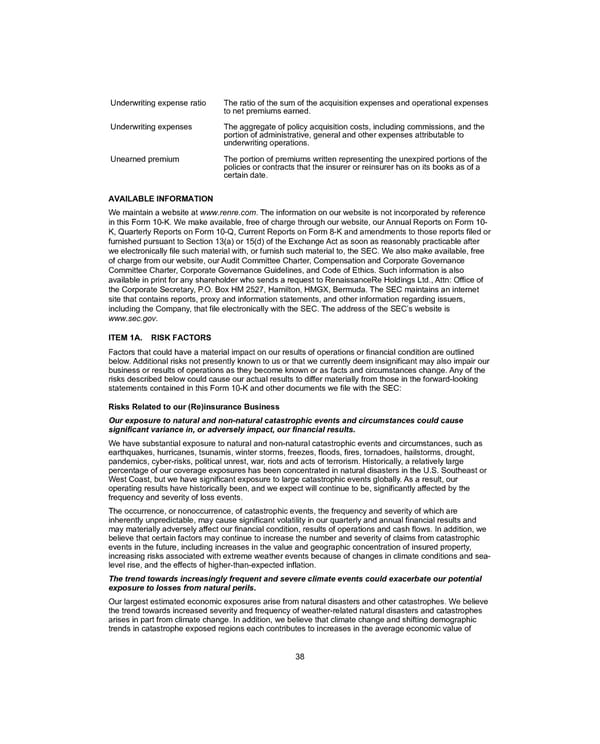Underwriting expense ratio The ratio of the sum of the acquisition expenses and operational expenses to net premiums earned. Underwriting expenses The aggregate of policy acquisition costs, including commissions, and the portion of administrative, general and other expenses attributable to underwriting operations. Unearned premium The portion of premiums written representing the unexpired portions of the policies or contracts that the insurer or reinsurer has on its books as of a certain date. AVAILABLE INFORMATION We maintain a website at www.renre.com . The information on our website is not incorporated by reference in this Form 10-K. We make available, free of charge through our website, our Annual Reports on Form 10- K, Quarterly Reports on Form 10-Q, Current Reports on Form 8-K and amendments to those reports filed or furnished pursuant to Section 13(a) or 15(d) of the Exchange Act as soon as reasonably practicable after we electronically file such material with, or furnish such material to, the SEC. We also make available, free of charge from our website, our Audit Committee Charter, Compensation and Corporate Governance Committee Charter, Corporate Governance Guidelines, and Code of Ethics. Such information is also available in print for any shareholder who sends a request to RenaissanceRe Holdings Ltd., Attn: Office of the Corporate Secretary, P.O. Box HM 2527, Hamilton, HMGX, Bermuda. The SEC maintains an internet site that contains reports, proxy and information statements, and other information regarding issuers, including the Company, that file electronically with the SEC. The address of the SEC’s website is www.sec.gov . ITEM 1A. RISK FACTORS Factors that could have a material impact on our results of operations or financial condition are outlined below. Additional risks not presently known to us or that we currently deem insignificant may also impair our business or results of operations as they become known or as facts and circumstances change. Any of the risks described below could cause our actual results to differ materially from those in the forward-looking statements contained in this Form 10-K and other documents we file with the SEC: Risks Related to our (Re)insurance Business Our exposure to natural and non-natural catastrophic events and circumstances could cause significant variance in, or adversely impact, our financial results. We have substantial exposure to natural and non-natural catastrophic events and circumstances, such as earthquakes, hurricanes, tsunamis, winter storms, freezes, floods, fires, tornadoes, hailstorms, drought, pandemics, cyber-risks, political unrest, war, riots and acts of terrorism. Historically, a relatively large percentage of our coverage exposures has been concentrated in natural disasters in the U.S. Southeast or West Coast, but we have significant exposure to large catastrophic events globally. As a result, our operating results have historically been, and we expect will continue to be, significantly affected by the frequency and severity of loss events. The occurrence, or nonoccurrence, of catastrophic events, the frequency and severity of which are inherently unpredictable, may cause significant volatility in our quarterly and annual financial results and may materially adversely affect our financial condition, results of operations and cash flows. In addition, we believe that certain factors may continue to increase the number and severity of claims from catastrophic events in the future, including increases in the value and geographic concentration of insured property, increasing risks associated with extreme weather events because of changes in climate conditions and sea- level rise, and the effects of higher-than-expected inflation. The trend towards increasingly frequent and severe climate events could exacerbate our potential exposure to losses from natural perils. Our largest estimated economic exposures arise from natural disasters and other catastrophes. We believe the trend towards increased severity and frequency of weather-related natural disasters and catastrophes arises in part from climate change. In addition, we believe that climate change and shifting demographic trends in catastrophe exposed regions each contributes to increases in the average economic value of 38
 2021 Annual Report Page 53 Page 55
2021 Annual Report Page 53 Page 55